中西方建筑文化差异中英文版资料
- 格式:ppt
- 大小:6.14 MB
- 文档页数:34
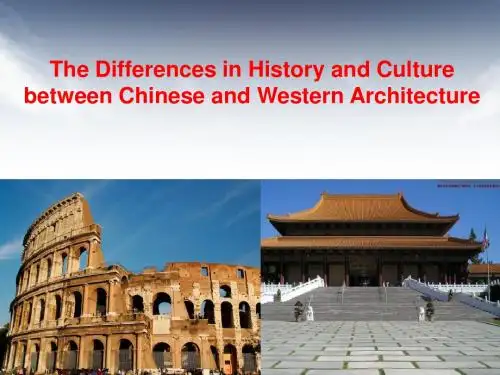

中西方建筑的差异英语作文The Distinctive Differences between Eastern and Western Architecture.Architecture, as a form of art and culture, reflectsthe values, beliefs, and aesthetics of a society. The Eastern and Western worlds, with their unique historical backgrounds, philosophical systems, and artistic traditions, have given rise to distinctly different architectural styles. This essay delves into the fundamental differences between Eastern and Western architecture, examining their historical evolution, design principles, materials, and spatial arrangements.Historical Evolution.Western architecture can be traced back to ancient Greece and Rome, where the principles of classical architecture were established. These principles强调symmetry, geometry, and the harmonious integration of formand function. Over time, Western architecture evolved through various styles, including Gothic, Renaissance, Baroque, and Modernism, each reflecting the social, political, and technological advancements of the era.On the other hand, Eastern architecture has a longer historical continuum, with roots in ancient China, India, and the Middle East. Eastern architectural styles have been influenced by Confucianism, Taoism, Buddhism, and other philosophical systems, which emphasize harmony with nature and the universe. Eastern architecture has also undergone significant transformations over time, but these changes have been more gradual and incremental compared to the Western tradition.Design Principles.Western architecture is known for its rationality and scientific approach. Architects emphasize the use of geometry and mathematics in design, striving for precision and balance. Western buildings are often characterized by their verticality, with tall towers and columns supportingheavy roofs. This verticality is a reflection of Western culture's emphasis on individualism and hierarchy.In contrast, Eastern architecture emphasizes horizontal lines and a harmonious relationship with the natural environment. Buildings are often designed to blend into the landscape, with roofs that slope toward the ground and facades that flow and curve. This horizontal emphasis reflects Eastern culture's emphasis on community and harmony.Materials and Techniques.Western architecture has historically relied heavily on stone as a primary building material. Stone's durability and permanence have contributed to the long-lasting nature of many Western buildings, which often stand for centuries. Stone has also allowed for more intricate and detailed carvings and sculptures, enhancing the aesthetic value of Western architecture.Eastern architecture, on the other hand, hastraditionally used wood as the primary building material. Wood's flexibility and ease of workability have allowed for more innovative and adaptive designs in Eastern architecture. Wooden buildings are also more in tune with the natural environment, as they can easily blend into the surrounding landscape.Spatial Arrangements.Western architecture typically follows a rigid grid system, with rooms and spaces arranged in a symmetrical manner. This arrangement is designed to maximize efficiency and functionality, with each room serving a specific purpose. Western buildings often have a clear hierarchy of spaces, with public and private areas clearly delineated.In contrast, Eastern architecture emphasizes flow and continuity. Spaces are often interconnected and overlap, creating a sense of openness and interconnectedness. Eastern buildings often have a more organic layout, with spaces designed to adapt to the needs and activities of the occupants.Conclusion.The differences between Eastern and Westernarchitecture are as vast as the cultures that gave them birth. Western architecture, with its rationality, verticality, and stone construction, reflects the individualism and hierarchy of Western culture. Eastern architecture, with its horizontal lines, harmonious blend with nature, and wooden construction, embodies the community, harmony, and flow of Eastern culture. Understanding these differences not only enhances our appreciation for the beauty and diversity of architecture but also provides insights into the values and beliefs that shape our world.。
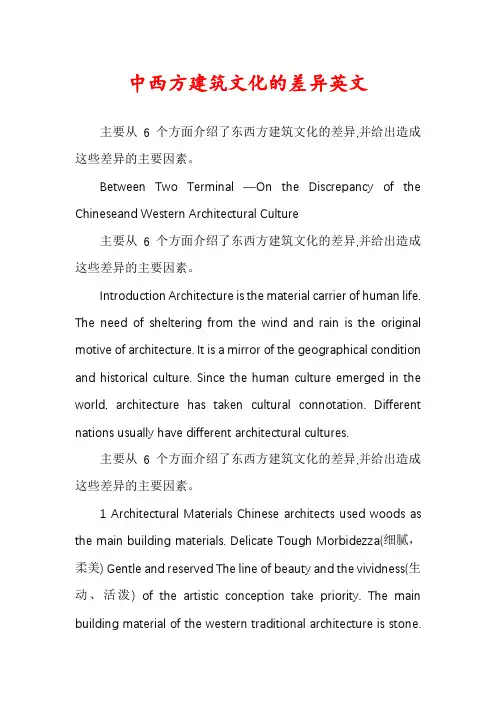
中西方建筑文化的差异英文主要从6个方面介绍了东西方建筑文化的差异,并给出造成这些差异的主要因素。
Between Two Terminal ―On the Discrepancy of the Chineseand Western Architectural Culture主要从6个方面介绍了东西方建筑文化的差异,并给出造成这些差异的主要因素。
Introduction Architecture is the material carrier of human life. The need of sheltering from the wind and rain is the original motive of architecture. It is a mirror of the geographical condition and historical culture. Since the human culture emerged in the world, architecture has taken cultural connotation. Different nations usually have different architectural cultures.主要从6个方面介绍了东西方建筑文化的差异,并给出造成这些差异的主要因素。
1 Architectural Materials Chinese architects used woods as the main building materials. Delicate Tough Morbidezza(细腻,柔美) Gentle and reserved The line of beauty and the vividness(生动、活泼) of the artistic conception take priority. The main building material of the western traditional architecture is stone.Straightforward Simple Rigid Majestic(庄严的,宏伟的) The architectural form is thick and heavy.主要从6个方面介绍了东西方建筑文化的差异,并给出造成这些差异的主要因素。

中西方建筑文化的差异英文主要从6个方面介绍了东西方建筑文化的差异,并给出造成这些差异的主要因素。
Between Two Terminal ―On the Discrepancy of the Chineseand Western Architectural Culture主要从6个方面介绍了东西方建筑文化的差异,并给出造成这些差异的主要因素。
Introduction Architecture is the material carrier of human life. The need of sheltering from the wind and rain is the original motive of architecture. It is a mirror of the geographical condition and historical culture. Since the human culture emerged in the world, architecture has taken cultural connotation. Different nations usually have different architectural cultures.主要从6个方面介绍了东西方建筑文化的差异,并给出造成这些差异的主要因素。
1 Architectural Materials Chinese architects used woods as the main building materials. Delicate Tough Morbidezza(细腻,柔美) Gentle and reserved The line of beauty and the vividness(生动、活泼) of the artistic conception take priority. The main building material of the western traditional architecture is stone.Straightforward Simple Rigid Majestic(庄严的,宏伟的) The architectural form is thick and heavy.主要从6个方面介绍了东西方建筑文化的差异,并给出造成这些差异的主要因素。
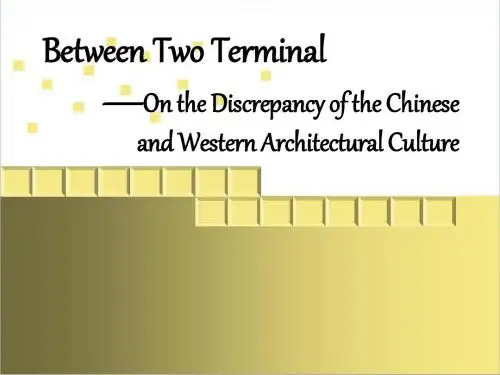
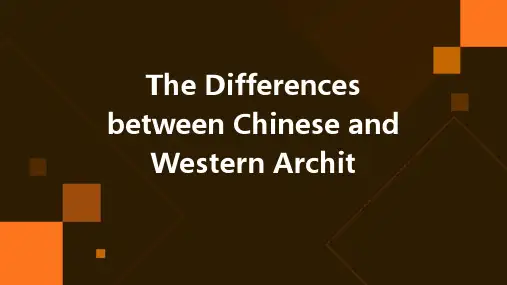
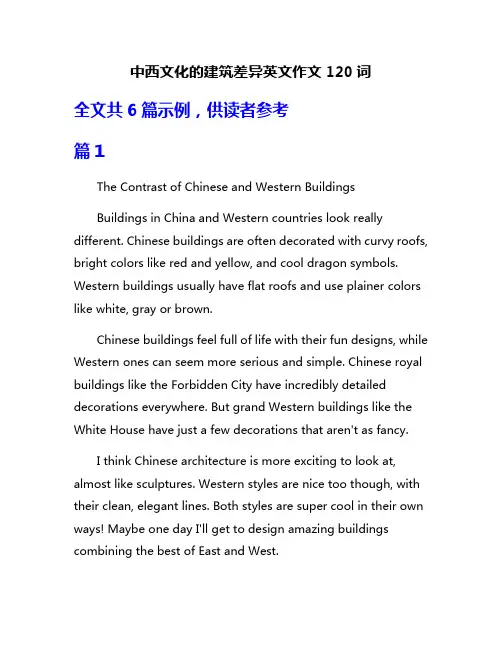
中西文化的建筑差异英文作文120词全文共6篇示例,供读者参考篇1The Contrast of Chinese and Western BuildingsBuildings in China and Western countries look really different. Chinese buildings are often decorated with curvy roofs, bright colors like red and yellow, and cool dragon symbols. Western buildings usually have flat roofs and use plainer colors like white, gray or brown.Chinese buildings feel full of life with their fun designs, while Western ones can seem more serious and simple. Chinese royal buildings like the Forbidden City have incredibly detailed decorations everywhere. But grand Western buildings like the White House have just a few decorations that aren't as fancy.I think Chinese architecture is more exciting to look at, almost like sculptures. Western styles are nice too though, with their clean, elegant lines. Both styles are super cool in their own ways! Maybe one day I'll get to design amazing buildings combining the best of East and West.篇2Different Places, Different BuildingsBuildings look really different in China compared to the West like America and Europe. In China, lots of old buildings have curved roofs that point up at the corners. They're called pagodas and temples. The roofs are made of ceramic tiles that are glazed and really colorful. The buildings are usually painted red and have cool designs of dragons or phoenixes.In the West, old buildings like churches have pointy roofs but the roofs aren't curved. The roofs are made of materials like slate or wooden shingles instead of ceramic tiles. The churches often have big fancy decorations but not usually dragons. The styles just look distinct.I think it's neat how architecture varies so much based on the culture and traditions of a place. Traveling lets you admire all the diverse architectural aesthetics around the world. Maybe I'll be an architect when I grow up!篇3Architectural Differences Between East and WestBuildings in China and Western countries look really different! Chinese buildings often have curvy roofs that stick up at the corners. They are decorated with dragons and other cool animals. The buildings are usually painted red, yellow and other bright colors. Western buildings have flat roofs and straight lines. They use a lot of glass, concrete and steel. The outsides are not as colorful or decorative.Chinese architecture is more about blending with nature. Buildings have open courtyards and gardens. Western architecture is about being modern and efficient. Buildings are taller to fit more inside. Chinese temples have intricate wooden carvings while Western churches have huge stained glass windows.Both styles are awesome in their own way! I like the vibrant colors and mythical creatures in Chinese architecture. But I also think Western skyscrapers look sleek and powerful. The world has so many awesome buildings to admire!篇4Chinese and Western Buildings Look Very DifferentChinese buildings look very different from Western buildings. Chinese buildings often have curved roofs that stick up at thecorners. They are usually painted red or yellow and have lots of cool decorations like dragons. The windows and doors also have pretty patterns carved into the wood.Western buildings are more plain-looking. They tend to have flat roofs and are made of bricks or stone. The windows are just rectangular holes in the walls without any fancy carvings. Churches and castles have tall spires and turrets that stick up into the sky though, which is kind of like the curved roofs on Chinese buildings.Both Chinese and Western styles are really neat, but in very different ways. Chinese buildings feel more ornamental and decorative, while Western ones are more simple and functional. I think it would be awesome to see them side-by-side!篇5Comparing Chinese and Western BuildingsHi there! My name is Lily and I'm 10 years old. Today I want to tell you about the big differences I've noticed between buildings in China and buildings in Western countries like the United States and England. It's really fascinating stuff!First off, Chinese buildings are often much more colorful and decorative than Western buildings. Take the Forbidden City in Beijing for example. It has these bright yellow roof tiles along with intricate wooden carvings of dragons and phoenixes. The buildings almost look like giant pieces of art! My parents told me the yellow roof color was reserved only for the emperor since yellow symbolizes royalty and power in Chinese culture.In contrast, a lot of older Western buildings use plain stone or brick on the outside without too many decorations. Buckingham Palace in London has a very simple tan brick exterior. I think Western architects wanted their buildings to look grand and stately, but not overly ornate.Another big difference is the types of roofs. Many traditional Chinese buildings have these awesome curving roofs that swoop upwards at the corners. My teacher says they are called "xuan" roofs. They're supposed to represent the curvature of the heavens. How cool is that? Whereas most Western roofs are flat or steeply slanted to let snow slide off easily.Chinese buildings also tend to be lower to the ground with just one or two floors. They spread outwards horizontally over a large area rather than going upwards vertically. My grandma told me this horizontal layout represents harmony with nature andthe earth. Whereas in big cities in the West like New York, you see all these skyscrapers reaching up towards the sky with dozens and dozens of floors stacked on top of each other. I guess Western architects wanted to maximize the amount of floor space in a small area of land.One final super interesting difference - many Chinese buildings incorporate courtyards and open spaces within the building's footprint. For example, the Summer Palace in Beijing has numerous gardens, ponds, and walkways interspersed between the different buildings. This allows people to always feel connected to nature even when inside. Most Western buildings on the other hand are closed off as single massive structures without much open space inside.There are so many other neat differences when it comes to windows, interior layouts, building materials used, and more! Learning about different architectural styles from around the world has been really eye-opening. Who knew buildings could be so diverse and interesting? I'm just scratching the surface here. Maybe I'll become an architect when I grow up so I can design amazing structures that blend the best of Eastern and Western influences!篇6There are many differences between Chinese and Western buildings. Chinese buildings often have curved roofs with special decorations on the corners, while Western buildings tend to have flat or pointed roofs. The colors used are different too - Chinese buildings frequently use red, yellow and green, but Western styles prefer whites, grays and browns.Inside, Chinese homes have large open spaces and sliding doors, but Western houses are divided into smaller rooms with swinging doors. The gardens around Chinese buildings have ponds, bridges and rock arrangements, whereas Western gardens have more lawns and flower beds.Both styles are very beautiful in their own way. Chinese architecture feels closer to nature, while Western buildings look grand and elegant. I'm glad we can enjoy the best of both in our modern cities!。
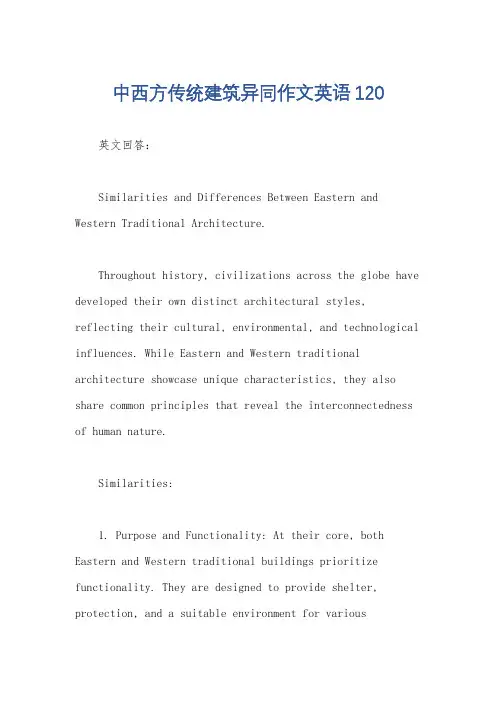
中西方传统建筑异同作文英语120英文回答:Similarities and Differences Between Eastern and Western Traditional Architecture.Throughout history, civilizations across the globe have developed their own distinct architectural styles, reflecting their cultural, environmental, and technological influences. While Eastern and Western traditional architecture showcase unique characteristics, they also share common principles that reveal the interconnectedness of human nature.Similarities:1. Purpose and Functionality: At their core, both Eastern and Western traditional buildings prioritize functionality. They are designed to provide shelter, protection, and a suitable environment for variousactivities.2. Use of Natural Materials: Traditionally, both architectural styles utilize local and readily available materials such as wood, stone, clay, and bamboo. These natural elements provide strength, durability, and a connection to the surrounding environment.3. Architectural Elements: Certain architectural elements are prevalent in both Eastern and Western styles. These include columns, beams, walls, roofs, and doors, which provide structural support, define spaces, and facilitate access.4. Symmetry and Balance: Many traditional buildings exhibit a sense of symmetry and balance, creating harmony and visual appeal. This aesthetic principle is often evident in facades, courtyards, and interior arrangements.Differences:1. Roof Design: Roof forms vary significantly betweenEastern and Western styles. Western buildings often feature pitched roofs with steep slopes to shed rainwater, while Eastern architecture commonly incorporates curved, sloping, or tiled roofs that create a distinctive aesthetic.2. Interior Planning: Western traditional architecture typically emphasizes separate rooms for different functions, while Eastern dwellings prioritize open and flexible spaces. This contrast reflects cultural differences in privacy and social interactions.3. Elevation: Western buildings tend to be taller and have multiple stories, while Eastern structures are often more horizontal and closer to the ground. This variation relates to differences in climate, available building materials, and cultural preferences.4. Ornamentation: Western architecture is often characterized by intricate carvings, moldings, and decorative elements, while Eastern styles often emphasize simplicity and minimalism. This distinction reflectscultural values and aesthetics.Conclusion:While Eastern and Western traditional architecture exhibit distinctive characteristics, they share fundamental principles of functionality, use of natural materials, and aesthetic considerations. These similarities reveal the universal human need for shelter, comfort, and beauty. Understanding the differences and similarities between these architectural styles fosters appreciation for the diversity of human creativity and the enduring legacy of our built heritage.中文回答:东西方传统建筑的异同。
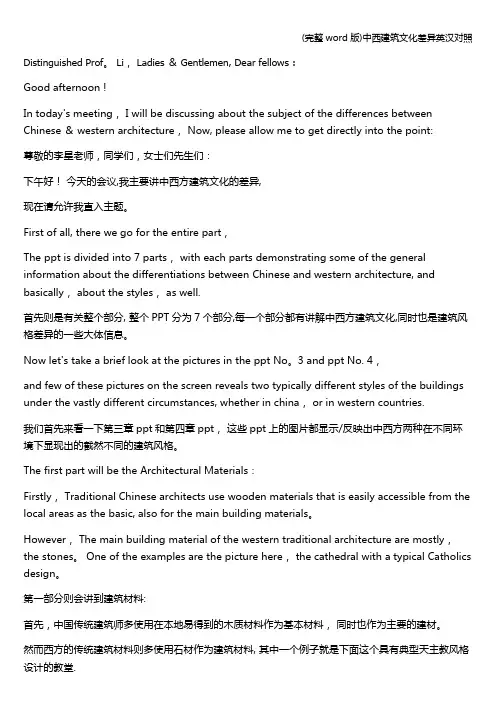
Distinguished Prof。
Li, Ladies & Gentlemen, Dear fellows :Good afternoon !In today's meeting, I will be discussing about the subject of the differences between Chinese & western architecture, Now, please allow me to get directly into the point:尊敬的李星老师,同学们,女士们先生们:下午好!今天的会议,我主要讲中西方建筑文化的差异,现在请允许我直入主题。
First of all, there we go for the entire part,The ppt is divided into 7 parts, with each parts demonstrating some of the general information about the differentiations between Chinese and western architecture, and basically, about the styles, as well.首先则是有关整个部分, 整个PPT分为7个部分,每一个部分都有讲解中西方建筑文化,同时也是建筑风格差异的一些大体信息。
Now let's take a brief look at the pictures in the ppt No。
3 and ppt No. 4,and few of these pictures on the screen reveals two typically different styles of the buildings under the vastly different circumstances, whether in china, or in western countries.我们首先来看一下第三章ppt和第四章ppt,这些ppt上的图片都显示/反映出中西方两种在不同环境下显现出的截然不同的建筑风格。
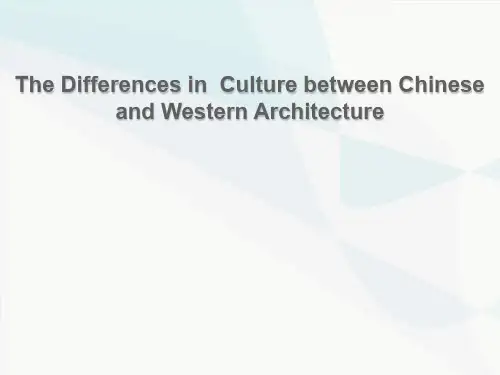
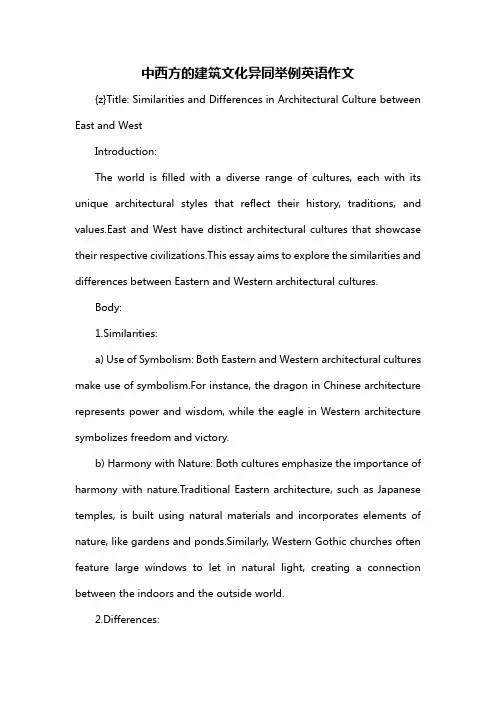
中西方的建筑文化异同举例英语作文{z}Title: Similarities and Differences in Architectural Culture between East and WestIntroduction:The world is filled with a diverse range of cultures, each with its unique architectural styles that reflect their history, traditions, and values.East and West have distinct architectural cultures that showcase their respective civilizations.This essay aims to explore the similarities and differences between Eastern and Western architectural cultures.Body:1.Similarities:a) Use of Symbolism: Both Eastern and Western architectural cultures make use of symbolism.For instance, the dragon in Chinese architecture represents power and wisdom, while the eagle in Western architecture symbolizes freedom and victory.b) Harmony with Nature: Both cultures emphasize the importance of harmony with nature.Traditional Eastern architecture, such as Japanese temples, is built using natural materials and incorporates elements of nature, like gardens and ponds.Similarly, Western Gothic churches often feature large windows to let in natural light, creating a connection between the indoors and the outside world.2.Differences:a) Style and Aesthetics: Eastern architecture is characterized by its use of intricate details, vibrant colors, and ornate decorations.The pagodas and temples in countries like Japan and China are excellent examples of this.In contrast, Western architecture tends to be more minimalistic, with an emphasis on proportion and symmetry.Buildings like the Parthenon in Greece represent this aesthetic.b) Structural Techniques: Eastern and Western architectural cultures differ in their structural techniques.Eastern architecture, particularly in countries like Japan, often uses wooden structures and sliding doors, which allow for flexibility and adaptability.Western architecture, especially during the Gothic period, utilized pointed arches and ribbed vaults to create large, open spaces.c) Functionality vs.Aesthetics: In Eastern architecture, functionality and practicality are often prioritized over aesthetics.Traditional Eastern homes, for example, are designed to maximize space and natural light.In contrast, Western architecture has a long history of prioritizing aesthetics, with buildings like the Colosseum in Rome being examples of grandeur and decoration.Conclusion:In conclusion, Eastern and Western architectural cultures have both similarities and differences.They both use symbolism and emphasize harmony with nature.However, they differ in terms of style, structuraltechniques, and the balance between functionality and aesthetics.Understanding these differences can help us appreciate the diverse range of architectural styles that exist in the world and learn from each other"s traditions.。
中西方的建筑文化异同举例英语作文英文回答:Architectural Differences Between East and West.The architectural traditions of the East and West have evolved over centuries, each influenced by unique cultural, historical, and environmental factors. While there are some similarities between Eastern and Western architecture, there are also several notable differences that set them apart.1. Form and Function.One of the most fundamental differences between Eastern and Western architecture is the emphasis on form and function. In Western architecture, there is often a clear separation between form and function. Buildings are typically designed to be visually pleasing and imposing, with an emphasis on symmetry, proportion, and order. InEastern architecture, however, form and function are often intertwined. Buildings are designed to be in harmony with their surroundings and to serve a specific purpose. They may be asymmetrical, organic, and less visually impressive than their Western counterparts.2. Materials.The materials used in construction can also vary significantly between Eastern and Western architecture. In the West, buildings are often made of stone, brick, or concrete. These materials are durable and long-lasting, but they can also be expensive and difficult to work with. In the East, buildings are more likely to be made of wood, bamboo, or paper. These materials are more flexible and easier to work with, but they are also more vulnerable to damage.3. Space.The concept of space is another area where Eastern and Western architecture differ. In Western architecture, spaceis often defined by walls and roofs. Buildings aretypically enclosed, with a clear distinction between the interior and exterior. In Eastern architecture, space is more fluid and open. Buildings are often designed with open courtyards and verandas, and there is a greater emphasis on the interaction between indoor and outdoor spaces.4. Decoration.Decoration is another important aspect of architecture that varies between East and West. In Western architecture, decoration is often used to embellish buildings and make them more visually appealing. This decoration can take many forms, from intricate carvings to colorful murals. In Eastern architecture, decoration is more restrained and often serves a symbolic or functional purpose. For example, the use of feng shui in Chinese architecture is intended to ensure that a building brings good luck and prosperity.5. Sustainability.Sustainability is becoming an increasingly importantconsideration in both Eastern and Western architecture. However, there are some differences in the way that the two regions approach this issue. In the West, sustainability is often achieved through the use of modern technologies, such as solar panels and energy-efficient appliances. In the East, sustainability is more often achieved through the use of traditional building techniques and materials, such as passive solar design and natural ventilation.中文回答:东西方建筑文化差异举例。
中西传统建筑的异同之处英文作文English:Traditional Chinese architecture and Western architecture have both similarities and differences. One key difference is the construction materials used. Traditional Chinese architecture primarily uses wood as the main building material, while Western architecture tends to utilize stone, brick, and concrete. Another difference lies in the architectural styles and designs. Chinese architecture focuses on symmetry, balance, and harmony with nature, often incorporating traditional beliefs and cultural elements into the design. On the other hand, Western architecture emphasizes innovation, functionality, and creativity, with a focus on geometric shapes and modern materials. Despite these differences, both Chinese and Western architecture share some similarities. Both have a rich history and cultural significance, with various architectural styles developed over centuries. Additionally, both traditions value craftsmanship, attention to detail, and aesthetics in their architectural creations. Overall, while there are distinct differences between Chinese and Western traditional architecture, they both represent unique culturalexpressions and serve as important reflections of their respective societies.中文翻译:中西传统建筑有着相似之处,也有不同之处。
中西方的建筑文化差异举例英语作文英文回答:Differences between Chinese and Western Architectural Culture.Chinese and Western architectural cultures have evolved over centuries, influenced by diverse geographical, historical, and cultural factors. As a result, they have developed distinct characteristics that reflect the unique values and traditions of each civilization.1. Form and Function.Western architecture has traditionally emphasized form and aesthetics, often prioritizing symmetry, balance, and grandeur. This is evident in iconic structures like the Parthenon in Greece or the Gothic cathedrals in Europe. Chinese architecture, on the other hand, has placed greater importance on functionality and harmony with nature.Buildings were designed to blend with their surroundingsand to serve specific practical needs.2. Materials and Construction Techniques.Western architecture has utilized various materials throughout history, including stone, wood, brick, and glass. These materials have allowed for the creation of towering structures with complex architectural details. Chinese architecture has emphasized timber construction, with elaborate wood-framing systems and tiled roofs. This construction technique has resulted in lightweight and flexible structures that can withstand earthquakes andother natural disasters.3. Symmetry and Asymmetry.Western architecture often employs symmetry and orderin its designs. This is reflected in the regular arrangements of windows, columns, and arches. In contrast, Chinese architecture embraces asymmetry and irregularity. Buildings may feature asymmetrical roofs, uneven walls, andmultiple courtyards. This approach creates a sense of balance and harmony without relying on strict symmetry.4. Openness and Enclosed Spaces.Western architecture has traditionally favored open spaces, with large windows and open-plan layouts. This is exemplified in structures like the glass-walled buildings of modernism. Chinese architecture, on the other hand, has placed more emphasis on enclosed spaces. Courtyards, screens, and partitions create intimate and private areas within larger structures.5. Feng Shui and Geomancy.Chinese architecture is deeply influenced by feng shui, an ancient practice that seeks to create harmony between buildings and their natural surroundings. Buildings are oriented according to the flow of qi (energy) and designed to promote good fortune and well-being. Westernarchitecture does not have a comparable concept, instead relying more on architectural principles like proportion,scale, and color.6. Vernacular Architecture.Western and Chinese vernacular architecture reflect the local traditions and materials of each region. In the West, this includes half-timbered houses in Europe, adobe buildings in the American Southwest, and log cabins in North America. In China, vernacular architecture varies from the traditional courtyard houses of northern China to the stilt houses of the southern coastal regions.中文回答:中西方的建筑文化差异。
中西方建筑文化的差异英文主要从6个方面介绍了东西方建筑文化的差异,并给出造成这些差异的主要因素。
Between Two Terminal ―On the Discrepancy of the Chineseand Western Architectural Culture主要从6个方面介绍了东西方建筑文化的差异,并给出造成这些差异的主要因素。
Introduction Architecture is the material carrier of human life. The need of sheltering from the wind and rain is the original motive of architecture. It is a mirror of the geographical condition and historical culture. Since the human culture emerged in the world, architecture has taken cultural connotation. Different nations usually have different architectural cultures.主要从6个方面介绍了东西方建筑文化的差异,并给出造成这些差异的主要因素。
1 Architectural Materials Chinese architects used woods as the main building materials. Delicate Tough Morbidezza(细腻,柔美) Gentle and reserved The line of beauty and the vividness(生动、活泼) of the artistic conception take priority. The main building material of the western traditional architecture is stone.Straightforward Simple Rigid Majestic(庄严的,宏伟的) The architectural form is thick and heavy.主要从6个方面介绍了东西方建筑文化的差异,并给出造成这些差异的主要因素。